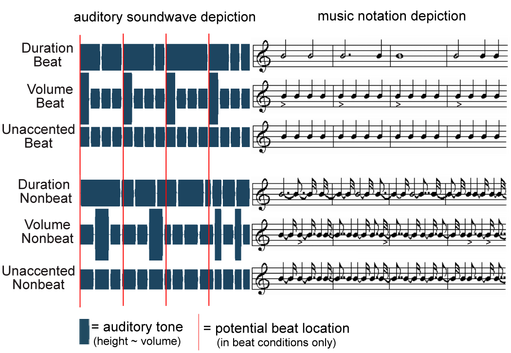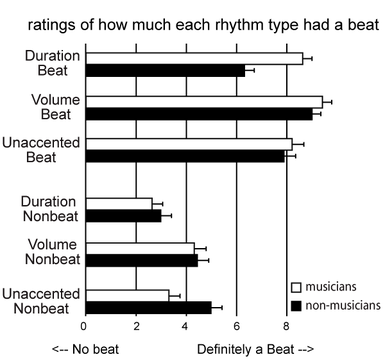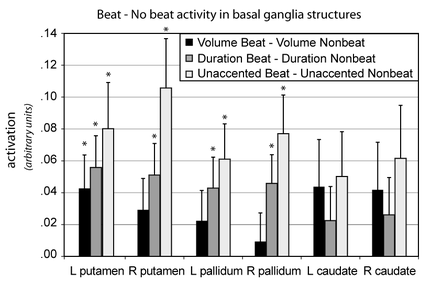Accents and feeling the beat.

This page describes a recent study investigating how different accent types influence rhythm perception (Grahn and Rowe, 2009) Stimuli We created rhythms that did or did not have a regular beat.
The first set were called Duration Beat because they used variations in duration to emphasize the beat.
The second set were called Volume Beat because they had volume accents to indicate the beat.
The third set were called Unaccented Beat because they did use any accents to emphasize the beat (this condition relies on the listener to internally emphasize certain tones, which we know from other studies that participants do spontaneously).
We also created control rhythms for each condition (Duration Nonbeat, Volume Nonbeat, Unaccented Nonbeat).
SOUND SAMPLES:
Duration Beat / Duration Nonbeat
Volume Beat / Volume Nonbeat
Unaccented Beat / Unaccented Nonbeat
Some examples are depicted on the right (about 3 seconds of a stimulus are depicted).
The first set were called Duration Beat because they used variations in duration to emphasize the beat.
The second set were called Volume Beat because they had volume accents to indicate the beat.
The third set were called Unaccented Beat because they did use any accents to emphasize the beat (this condition relies on the listener to internally emphasize certain tones, which we know from other studies that participants do spontaneously).
We also created control rhythms for each condition (Duration Nonbeat, Volume Nonbeat, Unaccented Nonbeat).
SOUND SAMPLES:
Duration Beat / Duration Nonbeat
Volume Beat / Volume Nonbeat
Unaccented Beat / Unaccented Nonbeat
Some examples are depicted on the right (about 3 seconds of a stimulus are depicted).
Behavioural results
Both musicians and non-musicians took part. Each of them rated each rhythm type on how clearly it had a beat.
|
Neuroimaging resultsWe then used fMRI to measure their brain activity while they listened to the rhythms. We found a pattern similar to what we found before, namely that beat rhythms activated the basal ganglia more than nonbeat rhythms did.
|

